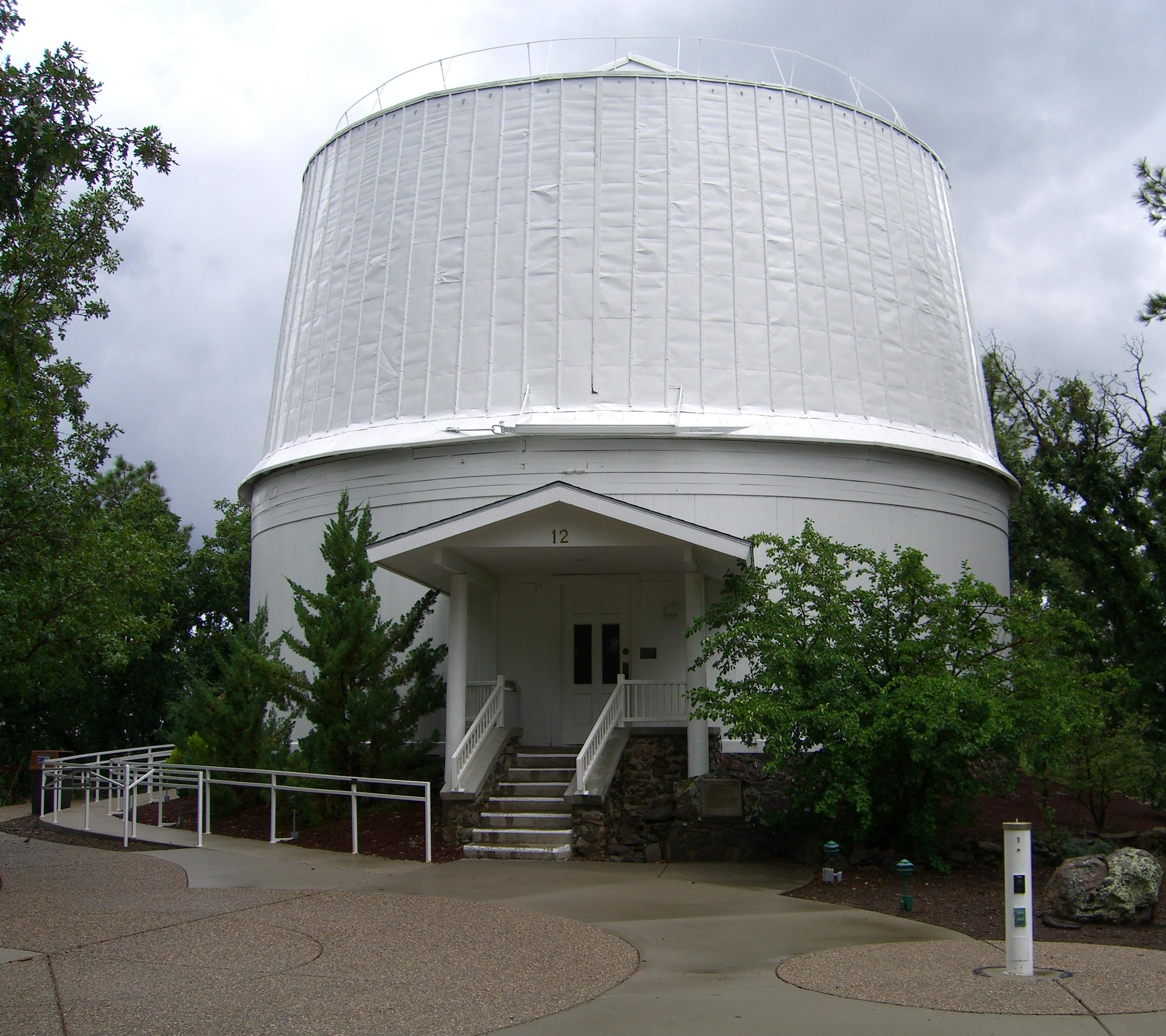
Lowell Observatory
Lowell Observatory is an astronomical observatory in Flagstaff, Arizona, United States. Lowell Observatory was established in 1894, placing it among the oldest observatories in the United States, and was designated a National Historic Landmark in 1965.[2][3] In 2011, the Observatory was named one of "The World's 100 Most Important Places" by Time Magazine.[4] It was at the Lowell Observatory that the dwarf planet Pluto was discovered in 1930 by Clyde Tombaugh.
Not to be confused with Lovell Telescope.Alternative names
Flagstaff Observatory
Private institution
2,210 m (7,250 ft)
1894
4.28 m (169 in) telescope (located at Happy Jack, Arizona)
4.28 m (169 in) telescope (located at Happy Jack, Arizona)
180 cm (72 in) cassegrain telescope (located at Anderson Mesa)
110 cm (42 in) Ritchey-Chretien telescope (located at Anderson Mesa)
79 cm (31 in) reflecting telescope (located at Anderson Mesa)
64 cm (25 in) catadioptric (located at Anderson Mesa)
61 cm (24 in) Alvan Clark refractor
53 cm (21 in) reflecting telescope
46 cm (18 in) astrograph
41 cm (16 in) Boller and Chivens cassegrain telescope
33 cm (13 in) astrograph
(located at Anderson Mesa)
six-aperture astronomical interferometer with baselines up to 437 m (1,434 ft) (located at Anderson Mesa, operated in partnership with the USNO (through NOFS) and the NRL)
1894
Flagstaff MRA (AD)
October 15, 1966[1]
December 21, 1965[2]
The observatory was founded by astronomer Percival Lowell of Boston's Lowell family and is overseen by a sole trustee, a position historically handed down through the family. The first trustee was Lowell's third cousin Guy Lowell (1916–1927). Percival's nephew Roger Putnam served from 1927 to 1967, followed by Roger's son Michael (1967–1987), Michael's brother William Lowell Putnam III (1987–2013), and current trustee W. Lowell Putnam.
Multiple astronauts attended the Lowell Observatory in 1963 while the moon was being mapped for the Apollo Program.[4]
The observatory operates several telescopes at three locations in the Flagstaff area. The main facility, located on Mars Hill just west of downtown Flagstaff, houses the original 61-centimeter (24-inch) Clark Refracting Telescope, which is now used for public education, with 85,000 annual visitors. The telescope, built in 1896 for $20,000, was assembled in Boston by Alvan Clark & Sons and then shipped by train to Flagstaff. Also located on the Mars Hill campus is the 33-centimeter (13-inch) Pluto Discovery Telescope, used by Clyde Tombaugh in 1930 to discover the dwarf planet Pluto.
In 2014, the 8,000 square feet (740 m2) Putnam Center was opened.[5] This observatory included many rooms with tools that were useful to observers including a library for research, a room for processing photographic glass plates, multiple antique instruments used by previous astronomers, and many artifacts. The observatory does contain areas that are closed to the public view, although there are multiple places that tourists are welcome to visit.[4]
Lowell Observatory currently operates four research telescopes at its Anderson Mesa dark-sky site, located 20 km (12 mi) southeast of Flagstaff, including the 180-centimeter (72-inch) Perkins Telescope (in partnership with Boston University) and the 110-centimeter (42-inch) John S. Hall Telescope. Lowell is a partner with the United States Naval Observatory and Naval Research Laboratory in the Navy Precision Optical Interferometer (NPOI) also located at that site. The Observatory also operates smaller research telescopes at its historic site on Mars Hill and in Australia and Chile.
Past Anderson Mesa, on the peak of Happy Jack, Lowell Observatory built the 4.28-meter (169-inch) Lowell Discovery Telescope in partnership with Discovery Communications, Inc.
In 1877 the Italian astronomer Giovanni Schiaparelli purported to have discovered a series of martian canals. Percival Lowell had seen these drawings and was fascinated by the idea of artificial canals in Mars. In the winter of 1893, he devoted to use his wealth and connections to establish an observatory in the US. His wealth stemmed from his connection to the influential Boston Lowell family and his successful career as an investment banker. Lowell hired American astronomer Andrew E. Douglas to find a suitable location for the observatory and in 1894 they agreed to build it in Flagstaff, Arizona due to its elevation, dark night skies, and proximity to the railroad. The materials for the construction of the observatory were all sourced locally, but the Clark Refracting Telescope was assembled in Boston.[6]
The observatory has carried out a wide array of research. One of its programs was the measurement of the variability of solar irradiance.[7] When Harold L. Johnson took over as the director in 1952, the stated objective became to focus on light from the Sun reflecting from Uranus and Neptune.[7] In 1953, the current 53 cm (21-inch) telescope was erected.[7] Beginning in 1954, this telescope began monitoring the brightness of these two planets, and comparing these measurements with a reference set of Sun-like stars.[7]
Self-taught astronomer Robert Burnham Jr. was an employee at Lowell observatory from 1958 to 1979, being known for his Celestial Handbook.
Beginning in 2012, Lowell Observatory began offering camps for children known as LOCKs (Lowell Observatory Camps for Kids). The first camp was established for elementary students. Later on, in 2013, they added an additional camp program for preschool children. The following year they added another program for middle school students. ("Kelly", Manager at Lowell Observatory). Kids have the opportunity to learn hands-on about science, technology, engineering, and math (STEM) through a variety of activities that include games, experiments, story time, art, music, and more.
In 2016, Kevin Schindler published Lowell Observatory, a 128-page book containing over 200 captions and pictures. Arcadia Publishing's Images of America included it in their series, which increased the enthusiasm of space in the public. The book itself features the popular reputation of Lowell Observatory, encompassing the revolutionary research of scientists and how they contributed to the field of astronomy.[4][8]


